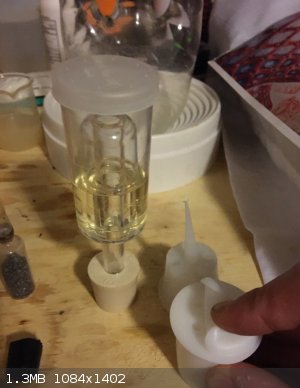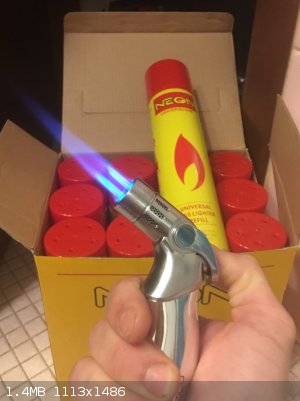Khemi
Harmless

Posts: 13
Registered: 20-9-2016
Member Is Offline
Mood: Hex n’ sex ftw
|
|
Inert atmosphere replacement?
So recently I ran a decarboxylation on l-tryptophan with acetophenone and found myself in need of argon to keep out oxygen and I read where someone
suggested using an airlock. Having taken up the boring art that is wine making, I had a few laying around that use a large plastic thimble like object
half submerged in water (I used mineral oil) which releases gasses but quickly seals that leak till pressure dictates another necessary release.
This appeared to work well and released a lot of pressure without issue but had I not had mineral oil and used water, the potential for disaster to
strike is a legitimate concern had water from the airlock stopper sucked into the reaction strolling along at 140c.
The possible solution to replacing the need for an inert atmosphere MAY be found at your local brewer making supplies shop. There you will find a new
breed of stopper that is made of high quality silicone and has a flap that covers the top area of the stopper and burps the gas once pressure is too
great.
Below are pictures of two different waterless airlocks I am hoping will replace the expense associated with owning a tank and regulator.
*note- I have not yet used the new waterless airlocks below since I just acquired them, both from different sources, each were roughly $6
Would these new style breathable stoppers be a viable alternative to needing an inert atmosphere? Are there any precautions necessary when using one
in these in this manner?

[Edited on 28-9-2018 by Khemi]
[Edited on 28-9-2018 by Khemi]
|
|
|
macckone
International Hazard
    
Posts: 2159
Registered: 1-3-2013
Location: Over a mile high
Member Is Offline
Mood: Electrical
|
|
If you truly need an inert atmosphere, you need to replace existing gas with an inert gas as well.
One that I have found useful is butane.
You can now buy it without odorizer for THC extraction in my state.
Either butane or carbon dioxide will work as an inert gas for many reactions.
You can also buy argon as a 'wine keeper' for about $15.
That last one should be available at high end wine shops.
It is only a few liters but if you really need it, it is perfect.
|
|
|
Khemi
Harmless

Posts: 13
Registered: 20-9-2016
Member Is Offline
Mood: Hex n’ sex ftw
|
|
Butane.. never heard of the stuff lol. Well, never heard of it being used as a inert gas and I’m sure it works for you but I’d rather stock 100
large argon tanks than use up my precious supply of butane when there’s a much safer less volatile Argon option for a few bucks less than the
deductible on my homeowners insurance. Besides, I’m gonna need all the butane I can get to keep this feisty little guy fed.

I hear what you’re saying about removal of gases produced by a run but wouldn’t that happen as the reaction proceeds as pressure would be
consistently pushing the gas out. LAH reductions for example. It’s not the evacuation of hydrogen that is being combated it’s the humidity. In
this example, this would be suffice. Or am I wrong?
Thanks for tip re: argon. If a reaction particular reaction demands a constant atmosphere change I know a few shops in that may have some. Beats going
to the welding supply house and having to spend 100-200 on a tank and regulator.
[Edited on 29-9-2018 by Khemi]
[Edited on 29-9-2018 by Khemi]
|
|
|
happyfooddance
National Hazard
   
Posts: 530
Registered: 9-11-2017
Location: Los Angeles, Ca.
Member Is Offline
Mood: No Mood
|
|
Quote: Originally posted by Khemi  | | Butane.. never heard of the stuff lol. Well, never heard of it being used as a inert gas and I’m sure it works for you but I’d rather stock 100
large argon tanks than use up my precious supply of butane when there’s a much safer less volatile Argon |
I wouldn't call argon less volatile, because it isn't, though I would say it's less disagreeable in several ways. If price is the factor butane wins
I'm afraid.
|
|
|
macckone
International Hazard
    
Posts: 2159
Registered: 1-3-2013
Location: Over a mile high
Member Is Offline
Mood: Electrical
|
|
I can get butane at $15 for 6 x 1 lb cans.
Argon is a couple of liters (STP) for the same price.
A lot of reactions that require that kind of inert atmosphere are going to be very flammable or reactive substances.
Butane is fine in a lab where precautions are already taken for ether which is often used as a solvent as the LEL is the same.
In an industrial setting the gasses of choice are carbon dioxide, nitrogen, and argon.
But hydrogen is also used for inerting reactions involving lithium as it is readily available from other processes.
I recently had a discussion online with a state rep from michigan as butane is used for THC processing there as well. They are looking to ban butane
for that use since it is 'dangerous' but they have only had one fire. Most people use this outside instead of inside.
|
|
|
Khemi
Harmless

Posts: 13
Registered: 20-9-2016
Member Is Offline
Mood: Hex n’ sex ftw
|
|
Quote: Originally posted by happyfooddance  |
I wouldn't call argon less volatile, because it isn't, though I would say it's less disagreeable in several ways. If price is the factor butane wins
I'm afraid. |
Fair enough, I should have chose a better word as you're right, the vapor pressure and evaporation rate is higher with Argon but both are denser than
air and therefore both are able to cause asphyxiation. That's where the potential hazards with Argon, end.
Mack, I would definitely feel comfortable using it outdoors but as a smoker, who has been awake for 14 hours now and only had 3 cigarettes (down from
10-20) that is a big factor. If I smoke I do so many feet away from any flammable chemicals and it's only on rare occasions I smoke inside and if I do
it's because I need to keep an eye on whatever it is that I am doing. Doesn't happen much and soon it won't happen at all because smoking is stupid
and I don't think I'm a stupid person but in all fairness the jury is still out on that one.
In regards to the original post, you can use the waterless airlock with decent success as I was able to get a crude yet high quality yield on my first
attempt decarboxylating tryptophan. Reaction time was considerably longer than the time stated in the experimental literature but that makes sense as
you scale up this reaction. 35g tryptamine from 40g tryptophan and what looks like a gram or two of moist tryptamine in need of a recrystallization.
The crude tryptamine mp 111-112c
Definitely replacing a liquid regulated air lock for reactions where moisture needs to be kept, and gas evolution is not problematic if it lingers
within the reaction vessel.
[Edited on 2-10-2018 by Khemi]
[Edited on 2-10-2018 by Khemi]
[Edited on 2-10-2018 by Khemi]
|
|
|